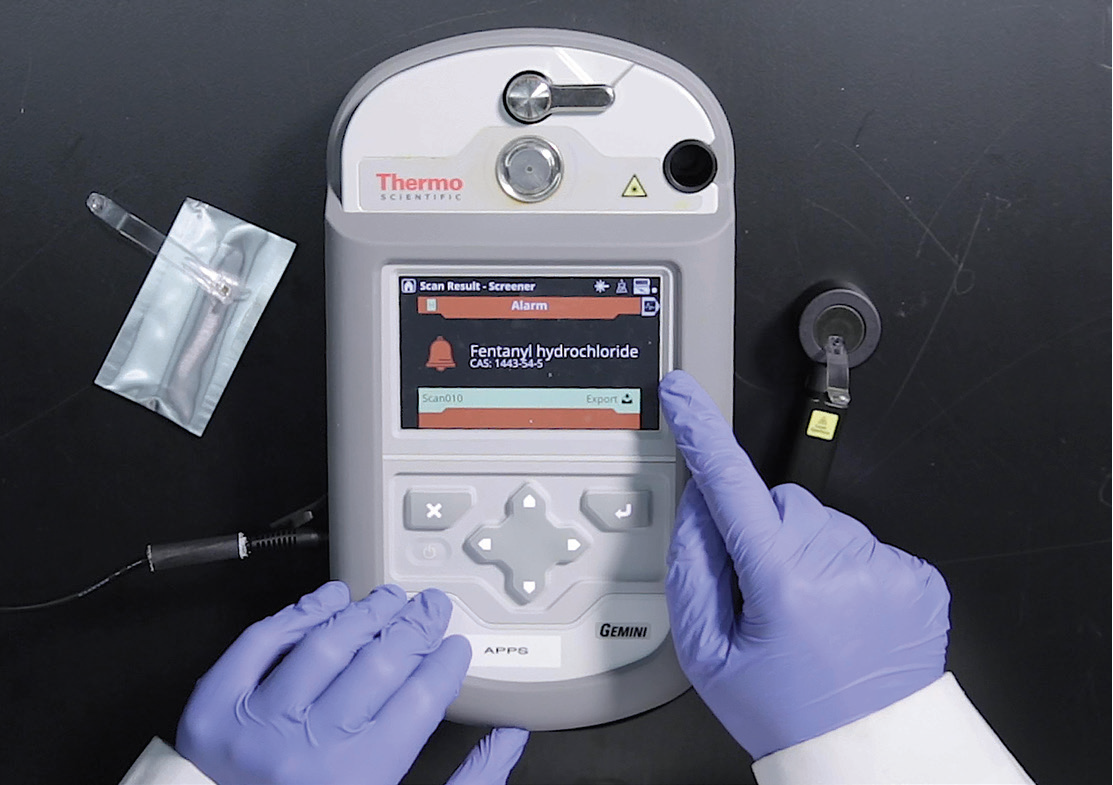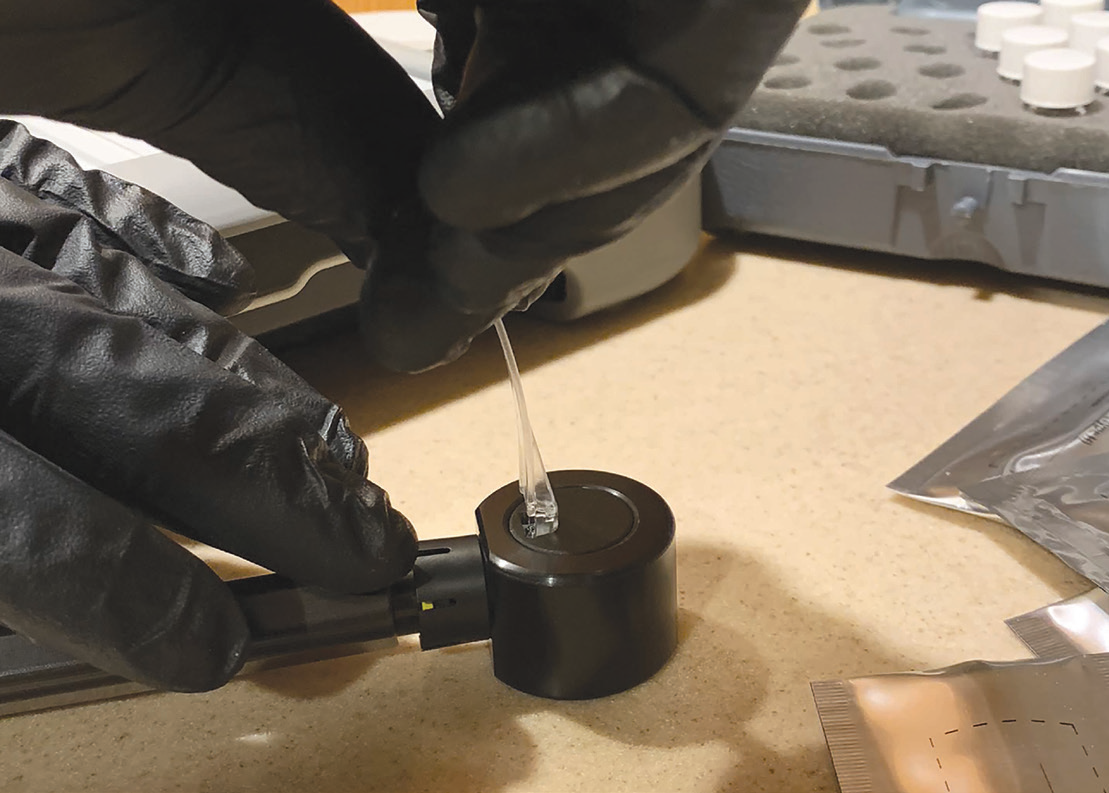The use of illegal or illicit drugs continues to be a growing problem worldwide; the ability to identify such substances helps to combat this issue.
The Thermo Scientific™ Gemini™ Analyzer, the world’s only handheld instrument incorporating both Raman spectroscopy and Fourier transform infrared (FTIR), has been successful in detecting and identifying illicit drugs. These two techniques are complementary in aiding a user in identifying unknown substances in the field.
Raman spectroscopy and FTIR can identify illicit drugs in high concentrations in mixtures and in pure form. Recently, the occurrence of very low concentrations (1 to 10 wt%) of illicit drugs such as heroin, fentanyl, and fentanyl analogs in pills and powdered mixtures has increased.
The detection of such drugs in low concentrations with standard Raman and FTIR spectroscopies is challenging. To aid law enforcement agencies in detecting lower drug concentrations in the field, the LowDoseID™ Gemini Analyzer has been introduced with two new improvements: the surface-enhanced Raman spectroscopy (SERS)-based H-Kit and the addition of a second Raman spectrum identification algorithm, Screener.

Image Credit: Thermo Fisher Scientific – Portable and Handheld Raman Spectroscopy
SERS-based H-Kit
Using the SERS technique, molecules of a substance are absorbed onto the surface of a nanostructure (e.g., nanoparticles or roughened metal surfaces, usually gold and/or silver), showing an enhanced Raman scattering signal under illumination with a laser.
The enhanced signal can be several orders of magnitude larger than a classic Raman signal, allowing for the detection of lower concentrations of illicit drugs.
The new H-Kit is made up of two parts: a plastic test stick containing a proprietary SERS substrate on one end and a vial comprising a solvent (methanol or ethanol). To use the kit, the user should take a small amount (2 to 4 mg) of a substance and place it into the solvent-containing vial, where it can dissolve.
After the substance is dissolved as much as possible and any remaining solid material has settled to the bottom of the vial, the SERS substrate is submerged into the solvent so that it is completely wetted. It is then removed and allowed to dry completely.
To analyze the absorbed chemical or chemicals, the substrate is placed onto a specialized test stick adapter, which has previously been attached to the Raman probe. A Raman spectrum is thus acquired.

Image Credit: Thermo Fisher Scientific – Portable and Handheld Raman Spectroscopy
Screener
The LowDoseID™ Gemini Analyzer also comprises a second Raman spectrum analysis algorithm, Screener, which is similar to the Thermo Scientific™ TruNarc™ Analyzer developed for identifying pure drugs as well as those in mixtures.
As well as being able to detect unknown substances in a sample, the Screener algorithm allows the detection of a specific substance of interest and can analyze both normal Raman spectra and SERS H-Kit spectra.
The algorithm uses an “alert configuration” file containing the substances a user wants to screen for. The instrument has a preloaded default file containing around 600 common illicit drugs, precursors, and cutting agents, which are classified as “alarm,” “warning,” and “clear.”
Users can develop their own customized file of substances, which can be moved between classifications, added to the file from the instrument’s Raman factory library (containing more than 12,700 items) or from a user-generated library and deleted from the file.
After analysis, the Screener algorithm displays results in a hierarchy; if one or more “alarm” items are identified, these alone will be displayed on the screen. If no “alarm” items are identified, then “warning” items will be displayed; “clear” items will be shown if no substances in the other two classifications are identified.
This display method is different to the standard ID algorithm, which shows all substances identified.
Illicit drug detection
The LowDoseID™ Gemini Analyzer contains a Raman factory library of over 700 illicit drugs, including heroin, cocaine, fentanyl, fentanyl analogs, synthetic opioids, methamphetamine, synthetic cannabinoids, phenethylamines and cathinones.
It also contains several precursors and cutting agents; any items can be moved from the library to the “alert configuration” file.
The Raman factory library also contains 40 SERS H-Kit spectra of common drugs and cutting agents for use within the Screener algorithm. If a substance is unavailable in the library, a user can acquire their own library-quality spectrum and add it to a user library.
Conclusion
The Gemini Analyzer equipped with LowDoseID™ enhances the detection capabilities for illicit drugs, thanks to the addition of the SERS H-Kit and improvements to the Screener algorithm. These advancements enable the detection of drugs at low concentrations, even within mixtures and pills.
Given the rising prevalence of highly toxic drugs in small quantities, the upgraded Gemini Analyzer with LowDoseID becomes an invaluable tool for law enforcement and border protection agencies in their analytical detection and identification efforts.
About Thermo Fisher Scientific – Portable and Handheld Raman Spectroscopy
Thermo Fisher Scientific offers innovative solutions that help our customers solve complex analytical challenges, accelerate life sciences manufacturing, deliver medicines to market, and increase laboratory productivity. Our Thermo Scientific portable and handheld process Raman analyzers enable accurate, real-time results for process monitoring.
The Thermo Scientific™ MarqMetrix™ All-In-One Process Raman Analyzer is an all-in-one system purpose-built for rapid deployment, ease of use, and scalability in markets where time-to-results is critical. The MarqMetrix All-In-One Process Raman Analyzer is designed for:
- Analysis without sample preparation, delivering Raman spectral results in real-time
- Easy setup and deployment by non–Raman spectroscopists
- Non-destructive workflows to protect precious samples
- Non-invasive handling to minimize contamination of samples
- Small footprint for convenient deployment
- Factory calibration for hardware stability and portability
Our Thermo Scientific TruScan™ Handheld Raman Analyzers includes state-of-the-art optics paired with a patented multivariate residual analysis that offers an effective chemometric solution for material identification, with two spectral pre-processing options. The non-destructive point-and-shoot sampling principle facilitates rapid verification of a broad range of chemical compounds, including cellulose-based products.
The TruScan™ G3 Handheld Raman Analyzer continues the evolution of raw material ID testing for pharmaceutical and biotechnology manufacturing quality control processes with:
- Incoming raw material identification (RMID)
- Dispensing of materials during API manufacture
- Finished product inspection
- Identification of falsified (counterfeit) medicines
- Enables non-technical operators to rapidly perform raw material ID testing without the need of a lab
The TruScan™ RM Handheld Raman Analyzer takes pharmaceutical manufacturing QA/QC to the next level with:
- Enhanced 21 CFR Part 11 and cGMP compliance with biometric login, complex password options, and full audit trail features
- Non-contact analysis through plastic bags, glass containers, blister packs and clear gel caps
- Intuitive workflow adapted to production environment through PDF batch reports and ease of data input using barcode scanners
- Easy fleet management feature that enables cloning of instruments and identification methods
Sponsored Content Policy: News-Medical.net publishes articles and related content that may be derived from sources where we have existing commercial relationships, provided such content adds value to the core editorial ethos of News-Medical.Net which is to educate and inform site visitors interested in medical research, science, medical devices and treatments.